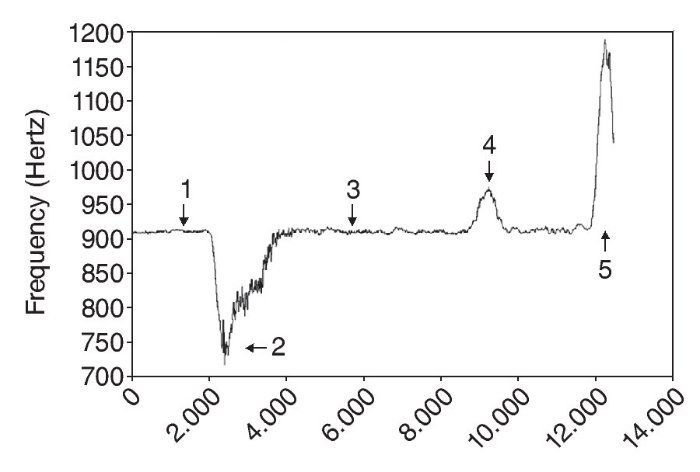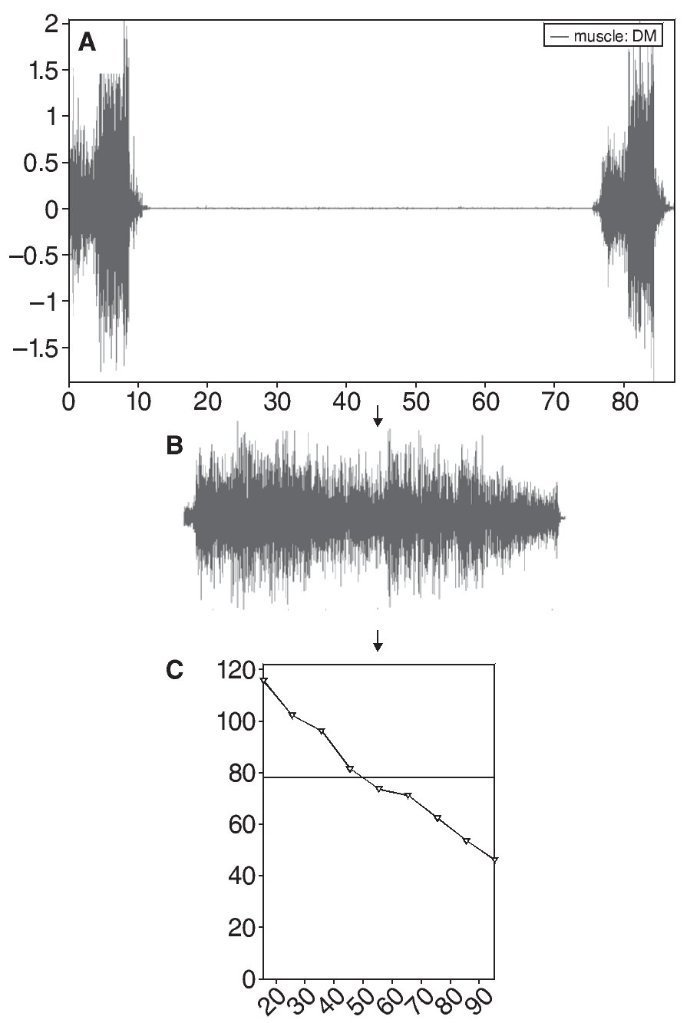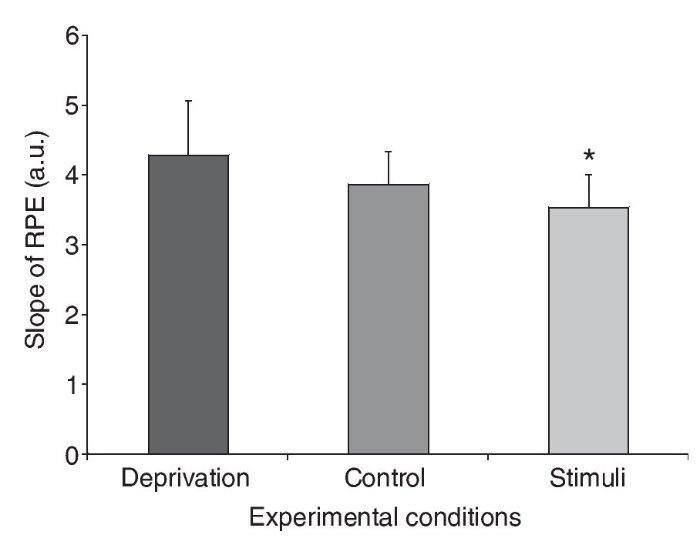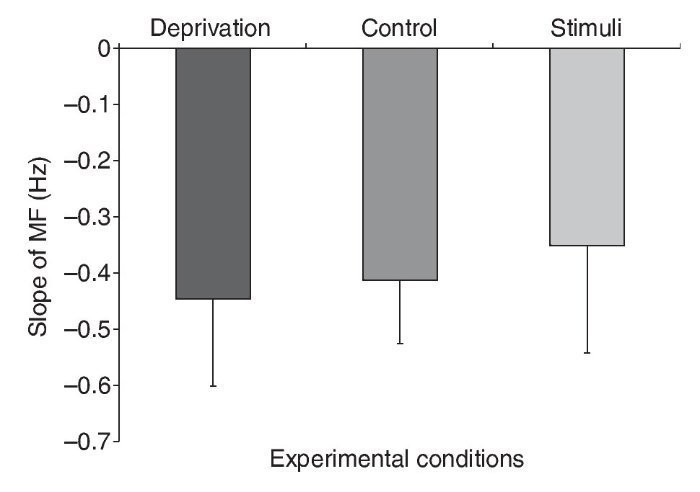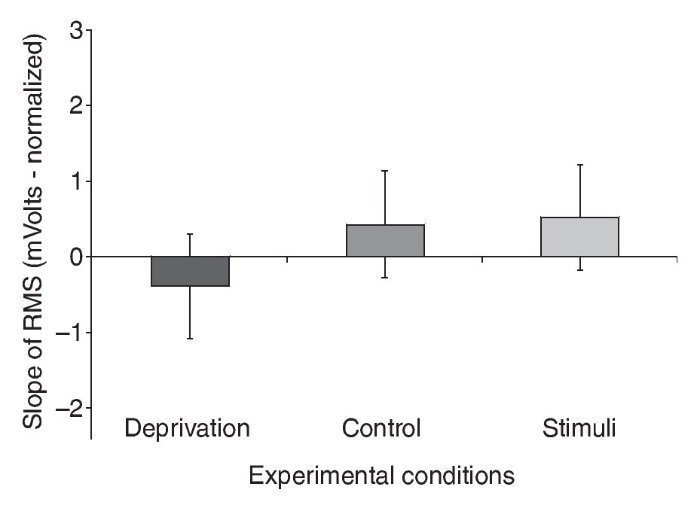Objetivo. El uso de la música y el video en la realización de los ejercicios pueden actuar en paralelo con otras señales fisiológicas y su interpretación central podría cambiar el esfuerzo percibido y posteriormente la actuación.
El propósito de este estudio fue verificar el efecto de la modulación sensorial en una actividad isométrica máxima del músculo.
Método. Diez voluntarios realizaron tres pruebas en las que tenían que mantener la abducción del brazo hasta la extenuación mientras se obtenían las siguientes variables: el tiempo total, tasa de esfuerzo percibido (TEP) y los indicadores de actividad muscular (frecuencia media (FM) y raíz cuadrada de la media (RCM)). Cada individuo realizó un control (CO), privación (PR) y condición de estímulos (CE).
Resultados. No se encontraron diferencias significativas en la actividad muscular entre las condiciones y el rendimiento (p > 0,05). La pendiente de TEP fue significativamente mayor a la PR en comparación con CE (4,3 + 0,77 a.u. vs 3,53 + 0,46 a.u., p < 0,05, respectivamente). Además, se encontró una mayor probabilidad en el tiempo de agotamiento en CE en comparación con PR (97 %) y CO (92 %), y menos probabilidad de que el rendimiento sea encontrado en PR en comparación con CO (59 %).
Conclusión. Se concluyó que una estrategia sensorial fue capaz de modular TPE y rendimiento.
Objetive. The use of music and video in exercise domain might act in parallel over other physiological signals and its central interpretation may change the rate of perceived exertion and subsequently the final performance.
The purpose of this study was to examine the effects of sensorial modulation in an isometric muscular endurance task.
Method. Ten volunteers have performed three tests, in which they had to keep the dominant arm abduction until exhaustion whilst the following variables: total time, rate of perceived exertion (RPE),median frequency (MF) and root mean square (RMS) were monitored. Each subject has performed a control (CO), deprivation (DP) and stimuli (SC) condition. Analysis of variance (ANOVA) one-way was applied followed by post-hoc Scheffé test. The smallest worthwhile change was used to provide a qualitative analysis of performance.
Results. No significant differences were found in muscular activity between conditions and performance (p > 0.05). The slope of RPE was significant higher to DP compared to SC (4.3 + 0.77 a.u. vs 3.53 + 0.46 a.u., p < 0.05; respectively). Furthermore, a higher probability of improvement for time to exhaustion was found to SC compared to DP (97 %) and CO (92 %), conversely the opposite outcome was demonstrated to DP compared to CO (59 %).
Conclusion. It was concluded that a sensory strategy was capable to modulate RPE and performance.
INTRODUCTION
The applications of sensory strategies as music and video have been highlighted by many studies on physical exercise domains1-10. Additionally, those have provided meaningful results to psychophysiological and performance variables11-14.The explanation of this phenomenon is called parallel process, a kind of mechanism inside the brain capable to identify the importance level behind each afferent signal, selecting which of them really deserve the full or partial interpretation15,16. To explore this hypothesis, a whole framework of psychophysiological assessment has got to be done, evaluating performance achieved, psychological and physiological state of subjects is very important to obtain a general aspect and take correct decisions.
To illustrate this point of view, low-intensity physical exercises as walking in a comfortable pacing might cause soft perceptions about heart or respiratory rate, on the other hand, when the activity increase such intensity (e.g. running at 8 km/h) the muscular afferent signals receive importance and the rate of perceived exertion tends to surge17,18. When the task presents a high-intensity, a great number of afferent feedback from muscles and other physiological components are sent to the brain and their interpretations might produce the final perceived exertion, which is sometimes responsible for influencing final performance15,16.
This interpretation occurs through an attentional focus, which selects what is more important at that time or what should receive more signals, allowing at initial moments of such task with low-intensity be sought-after by audios or visual signals, acting as a tool to extend the final point to exhaustion12,19. In activities involving the whole body, subjects may control what they do and what will be done to complete the exercise with the highest success20-22, therefore, activities involving open-loop circuit with established workload may show greater alterations from sensory organs2,21.
There is a great amount of studies involving sensory strategies, which can contribute with exercise and sport domains23-29, in majority; they include an increasing audios feedback, and finally reporting better results to performance or psychological state30. However, deprivation of sensory feedback might bring fatigue sensations in advance. Thereby, the purpose of this study was to investigate the effects of music and video in an isometric muscular endurance task.
METHOD
Subjects
For this study, 10 health men were selected (21,0 ± 1,5 years, 69,8 ± 5,2 kg, 175,0 ± 4,0 cm), who were students of sport sciences from the Faculdade de Motricidade Humana - Universidade Técnica de Lisboa - Portugal (FMH-UTL), recruited from sports science classes. After a brief explanation about the study, the subjects that accepted to participate in the research had signed a term of consent informing the objectives and possible risks of the research. This study was approved by the local Ethics Committee.
Experimental approach to the problem
First of all, the subjects were informed they could not practice any kind of physical exercises at the day before the test as well as in the test day.
Secondly, they have passed by three experimental conditions; deprivation (DP), stimuli (SC) and control (CO) that were performed at three different moments and in a random order, as a way to nullify the effect of learning during the sessions.
The task consisted of keeping the arm at the abduction position (angle near 90° of the body) until exhaustion. The forearm had to keep a full extension and the arm should be positioned in a 0° rotation (thumb forward). An electrogoniometer (BioPlux®) was used to measure the angle between the arm and the body, allowing a maximum of 10° variation. Any extra fall over than 80° or any corporal compensation to the left side was considered fatigue and any of these situations the task was stopped; an example is presented at figure 1. All the arm position variations was analyzed by an electrogoniometer positioned in the posterior wrist region, which was associated with a telemetry system for collection of biological signals BioPLUX® research 2010 (PLUX, Lisbon, Portugal). The electrogoniometer signal processing was performed by a MATLAB® routine software V.R2010a (The Mathworks Inc., Natick Massachusetts, USA) defined for this purpose. The point that corresponded with 50Hz represented fatigue (10°).
Fig. 1. The curve interpretation through electrogoniometer. The arrow 1 shows the arm position at 0 o related to the trunk; the arrow 2 shows the arm variation to 90o (abduction) The arrow 3 shows a stable position at 90 o related to the trunk; the arrow 4 shows a little fall of abduction (50 Hz was considered the exhaustion moment); the arrow 5 shows the complete fall of arm to the initial point. Time: ms.
The RPE was measured using the Borg 15 point's scale31 during isometric shoulder abduction, being applied in the beginning of the task and every 30 seconds until the end. All the subjects were trained previously to use the Borg scale with the aim that they could choose and differentiate all of perceived exertion levels (even without vision and hearing situation).
Performance tests
The subjects were exposed to three experimental conditions: deprivation (DP), Stimuli (SC) and control (CO), with an interval of at least forty eight hours between sessions. Time keeping was done with a digital stopwatch accurate (1/1000 seconds) and started when the arm reached an abduction level of 90 degrees.
In the SC condition, the subjects were instructed to choose a music (motivational features; self-selected method) which was used to give them auditory and visual stimulus. Through headphones the volume was adjusted according to subjects' preference keeping always near decibels (± 75 decibels). The recommendation was that the chosen song could motivate them during a vigorous physical exercise. A television was used in front of the subjects to show the video clip from the chosen track as a form to increase the visual stimuli. They were asked to keep their eyes on the video clip throughout the task.
In the DP condition, earplugs (OHROPAX®) were used to deprive external noises; furthermore, their eyes were covered with an eyepatch to deprive them from visual stimuli. At this condition, the RPE measurement has been done in a different way, touching the subject on his left arm, on account of they could not hear or see anything, this is also important to note that the whole group of subjects were familiarized with this process previously.
In the CO condition the subjects only did the task in front a blank wall without stimuli or deprivation.
EMG signals analysis and processing
After warming-up (3 sets X 10 repetitions of abduction; 2 kg dumbbell), a maximum voluntary contraction (MVC) has been done for the median portion of the deltoid muscle, with a 2 minutes interval between each contraction for normalizing EMG signal purposes following all of the SENIAM's32 recommendations.
The skin of all subjects was cleaned with alcohol and shaved with a blade; this process allows decreasing the interface impedance between the skin and the electrode. The raw data was initially analyzed through visual inspection, in an attempt to identify eventual problems. Data processing have been made on MATLAB®.
The signal was submitted to a pass-band digital filter of 10 and 500Hz to smooth possible noises. In a second time, the cue was divided in a 10 second windows, to calculate the median frequency of each space (Fast Fourier Transform Spectrum Analysis). Subsequently, the raw signal was rectified and smoothed by a pass-band filter of 12Hz (Butterworth 4ª order). Finally, the signal was normalized taking the MVC value as a reference point (100 % of force production). The figure 2 presents the slope process of signal.
Fig. 2. Slope process from EMG signal. A: MVC signal; B: test signal; C: slope achievement of normalized signal.
Statistical analyses
Data were submitted to the Shapiro-Wilk's test to verify the normality distribution by the Gaussian curve for all variables. Thereafter, data were presented as mean and standard deviation. Analysis of variance (ANOVA) one-way was applied for all comparisons followed by a multiple comparison post-hoc test (Scheffé) to compare the RPE slope and the muscular activity (MF and RMS). All data were processed using the statistical package PASW Statistics 18.0, and the level of statistical significance was set at 5 %. A parallel statistic was used (smallest worthwhile change) proposed by Hopkins et al.33 to make a qualitative analysis of the main variable (total time). This analysis allows proposing possibilities of chance to classify the effect of the intervention to be trivial, beneficial or prejudicial. The chances existent in a test is usually classified in < 1 % almost sure that not; 1 % to 5 % very unlikely; 5 % to 25 % unlikely; 25 % to 75 % possible; 75 % to 95 % likely; 95 % to 99 % very likely; > 99 % almost sure. If the chance of beneficial effect and the decrease in performance were both higher than 5 %, the classification was considered undetermined.
RESULTS
The RPE values are shown in the figure 3. The RPE slope throughout the time presented higher outcomes for DP compared to SC (4.3 + 0.77 a.u. vs 3.53 + 0.46 a.u., p < 0.05; respectively).
Fig. 3. RPE slope in arbitrary units (a.u.) for the three experimental conditions *: differences between conditions stimuli vs deprivation (p < 0.05). n = 10.
The figure 4 shows the EMG Slope of MF. No statistical differences were found between the following groups: DP (- 0.44 + 0.15 Hz), CO (- 0.41 + 0.11 Hz) and SC (-0.35 + 0.18 Hz) (p > 0.05).
Fig. 4. Slope index of median frequency in Hz for the three experimental conditions (p > 0.05). n = 10.
The EMG slope of RMS is presented on figure 5. No statistical differences were found between the following groups: DP (- 0.39 + 1.35), CO (0.42 + 2.25) and SC (0.52 + 1.45) (p > 0.05).
Fig. 5. RMS slope (mVolts normalized) for the three experimental conditions, (p > 0.05). n = 10.
The total time analysis has also shown no significant differences (DP = 101.6 + 21.27s; CO = 107 + 19.51 s; SC = 119.6 + 23.41s, p > 0.05; respectively). On the other hand, the figure 6 shows the SWC results for the same dependent variable. It was found that there is 97 % (97/3/0) of possibility to achieve benefits of external stimulus compared to DP and 92 % (92/7/1) compared to CO. Moreover, the DP showed a disadvantage (59 % - 4/37/59) compared to CO, which might be considered as prejudicial.
DISCUSSION
The purpose of this study was to investigate the effects of music and video/sensory deprivation in an isometric muscular endurance task. This sensory strategy was capable to change the slope of RPE and the total time. The first outcome has been likely changed according to the feedback inducement, which presented higher values when the attentional focus was directed to physiological systems (DP).
Likewise, the opposite is apparently true. At the initial phases of exercise, the capacity from muscles to contract were higher and the capacity of brain to interpret other signals were also higher. Nonetheless, when the attentional focus was changed to sensory organs, influenced by music and video, a mechanism of interpretation competition began which decreased the RPE and extended the final point of the maximal exercise (SC).
Such differences were found by previous studies, usually know as load-dependent phenomenon, when Boutcher and Trenske2, evaluated 24 women and tested the use of music/deprivation on three different workloads on a cycle ergometer (18 - minute sessions), and verified that light and moderate intensities were probably affected by music/deprivation. This study has shown fewer responses of RPE and affective measures within music application, however, physiological assessments as heart rate remained the same. On this case, heart rate represents a phy siological measure as well as muscular activity in the present study.
Accordingly, the number of motor unities and the rate of fatigue represented through root mean square (time domain) and median frequency (frequency domain) did not change according to the experimental condition. This is important to note that the raw analysis of muscular activity may provide useful information, for instance, the contraction time and the muscular feedback were higher for SC compared to DP and CO. These performance differences using music and video were constantly tested by studies involving similar endurance tasks, which allows professionals and coaches using sensory techniques for decreasing perceived exertion and improve performance when necessary23. Crust (2004)3 has tested a similar task with different times to exposure, who evaluated 27 male undergraduate students submitted to three experimental conditions: prior exposure (music or white noise played immediately before the task); half exposure (conditions initiated simultaneously with task commencement but terminated approximately half-way through the trial); and fulI exposure (conditions initiated simultaneously with trial commencement and continuing until the end). Therefore, very similar outcomes have been found, which identified music as a fascinating tool for increasing performance and decreasing body perceptions through parallel mechanism effects.
This study presents several limitations: The use of RPE with closed eyes may disrupt the correct application of the scale, even with previous training of subjects for answering by memory; secondly, the number of subjects and possible heterogeneity of physical fitness to accomplish the task might highlight high random effects; thirdly, there was no familiarization process with all procedures; fourthly, the selection of music/video followed a very simple method of asking, which involves personal features and no standardization related to the motivational qualities of music and video; finally, the constant application of RPE scale, which is capable to change the correct answer34.
In conclusion, the use of music and video/sensory deprivation was capable to cause positive effects for RPE and performance in an isometric muscular endurance task. Further studies have got to investigate these sensory modulations on sports and exercise domains, in an attempt to clarify the correct mechanisms behind this.
Acknowledgments
The authors thank the Coordenação de Aperfeiçoamento de Pessoal de Nível Superior (CAPES) for graduate scholarships and financial support.
Conflict of interest
The authors declare that they have no conflict of interest.
History of the article:
Received September 29, 2012
Accepted June 12, 2013
Correspondence:
L. R. Altimari.
Departamento de Educação Física.
Universidade Estadual de Londrina.
Rodovia Celso Garcia Cid, PR 445 Km 380.
Campus Universitário, Cx. Postal 6001.
CEP 86051-990, Londrina, PR, Brasil.
E-mail:altimari@uel.br



